- Menu

OPERATION SIRLI
SUNDAY NOVEMBER 21 2021
Disclose has obtained hundreds of classified French official documents which reveal abuses committed during a secret military operation by France in Egypt. This investigation unveils how France became complicit in aerial strikes against civilians.
It was early in the morning on February 13th 2016, when a bus, with its passenger windows curtained, crossed through the gates of a military base beside the town of Marsa Matruh, which lies on the Mediterranean coast about 570 kilometres west of Cairo. It was a Saturday, and the vehicle stopped in front of a group of sand-coloured huts. Ten men, all French, climbed out. They had arrived in Egypt a few days earlier on tourist visas.
They followed local soldiers into a building which had only basic equipment, along with a faulty air conditioning system and no water fountain. It would become their headquarters, the command centre for a clandestine joint military operation by France and Egypt, codenamed “Sirli”.
Disclose has received several hundred classified documents provided by a source whose identity is protected here, and which reveal the abuses conducted during this intelligence mission, conducted in the name of the fight against terrorism, and which began in February 2016.
The documents, kept confidential under France’s national “national defence secrecy” regulations (“le secret de la défense nationale”), originate from the services of the presidential office, the Élysée Palace, the French armed forces ministry, and the French military intelligence services. They show how this military cooperation exercise, kept secret from the public, was diverted from its original mission, that of reconnaissance of terrorist activity, in favour of a campaign of arbitrary executions. It involved state crimes about which the French presidential office was kept constantly informed, but which took no action.
The Source"What causes the silence to be broken is the off-limits behaviour of French political-military action which profoundly stains that for which men and women place themselves in the service of France.”
The project for the mission began on July 25th 2015. That day, Jean-Yves Le Drian, the then French defence minister under the presidency of François Hollande, flew to Cairo along with the head of France’s military intelligence services, General Christophe Gomart, to meet with Egyptian defence minister Sedki Sobhi. The context, according to a French diplomatic document obtained by Disclose, was “extremely favourable […] based on the recent successes of the Rafale and FREMM contracts”. This was a reference to France’s sale to Egypt, in April that year, of 24 Rafale fighter jets and two multi-purpose frigates (FREMMs) for a total value of 5.6 billion euros.
SUPPORT NOT-FOR-PROFIT INVESTIGATIVE JOURNALISM
SUPPORT DISCLOSE
The meeting in Cairo was to discuss the securing of Egypt’s 1,200-kilometre-long border with Libya, a country in chaos. Sobhi notably raised the “pressing need” for information from aerial intelligence. Le Drian pledged to set up “operational and immediate cooperation” as part of a “global manoeuvre against terrorism”. This would take the form of a covert mission led by French military intelligence from an Egyptian military base.
There remained the step of the signing a cooperation agreement between the two countries. This would normally have detailed the objective of the operation, and allow the military staff to consult it and understand its outlines. According to information gained by Disclose, such a document was never signed.
The Source“This agreement would have obliged the two parties to to describe, black on white, the framework of the cooperation, the type of mission and, above all, its limitations.”
At the beginning of 2016, a French team was secretly sent to Egypt’s western desert region, one with a surface area of 700,000 square kilometres stretching from the River Nile to the border between Egypt and Libya. It was the start of operation Sirli. It involved ten people, made up of four soldiers and six former servicemen now working in the private sector – these were two pilots, and four systems analysts. The latter were employed by CAE Aviation, a Luxembourg-based company specialised in imaging and communications interception. CAE Aviation also rented out to the French military intelligence services, the DRM, the key tool for the operation; this was a Merlin III light aircraft equipped for surveillance and reconnaissance, which would act as the ears and eyes for the team.
Contacted by Disclose on several occasions, CAE Aviation declined to provide any comment.
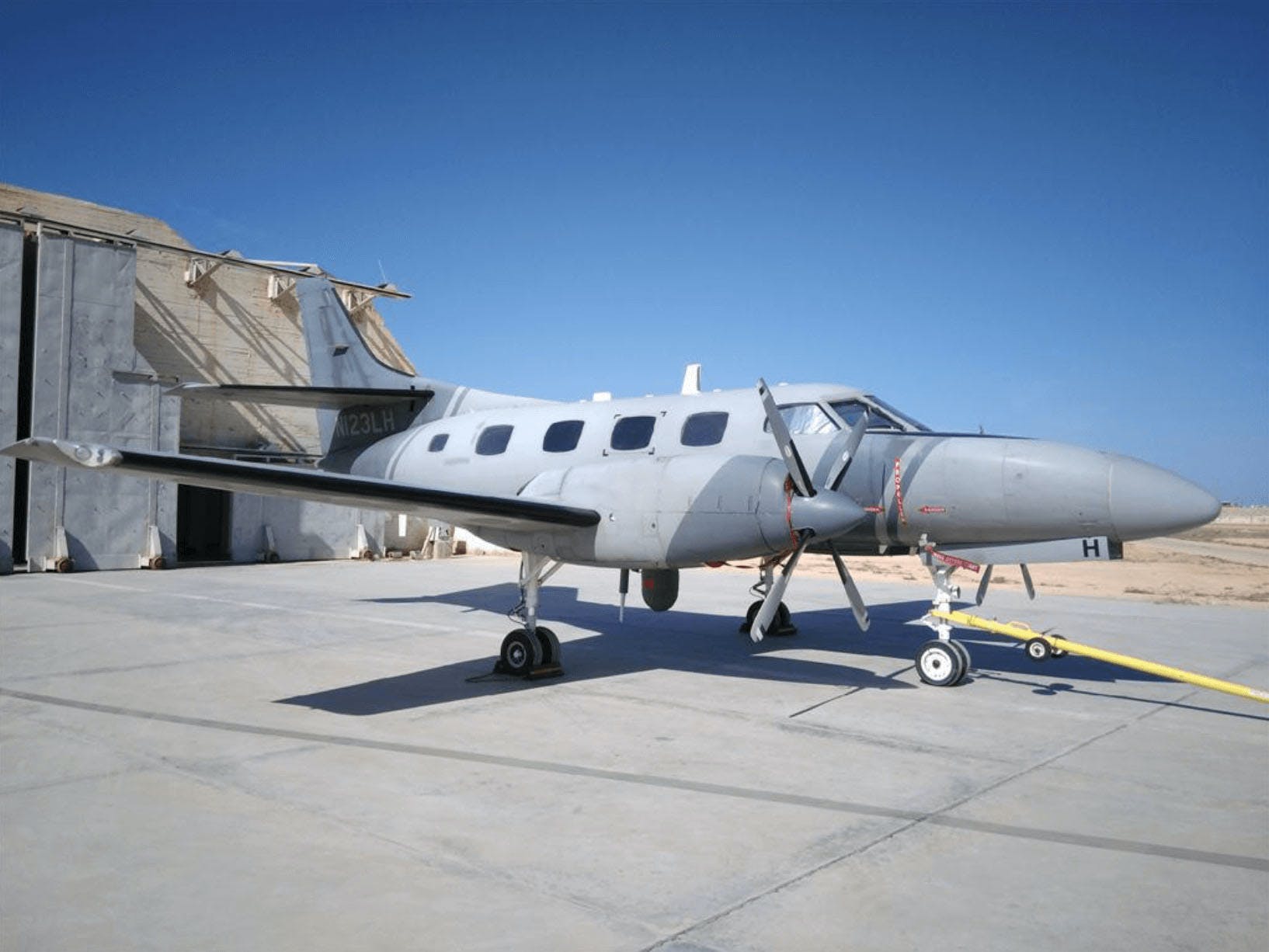
THE MERLIN III AT MARSA MATRUH IN EGYPT, PHOTOGRAPHED BY ONE OF THE AGENTS WHO TOOK PART IN OPERATION SIRLI.
In principle, the detachment mission, dubbed “ELT 16” (for “technical liaison team 16”), involved the surveillance of the western desert region to identify any eventual terrorist threat coming from Libya. On each excursion, the French team were accompanied by an Egyptian officer, who was tasked with listening in to the live eavesdropping of conversations. In theory, the information gained was to be cross-checked against other details in order to evaluate the reality of any threat and the identity of the suspects.
DISCLOSE IN YOUR MAILBOX
But very soon, the French team came to realise that they were being used to facilitate the murders of civilians who were suspected of smuggling activity. The team informed their hierarchy of this at regular intervals – over one year, and then two and, finally, three years – but in vain.
Their first doubts arose after barely two months into their mission, as illustrated by a DRM report dated April 20th 2016. The liaison officer for the mission informed his superiors that the Egyptians wanted “to lead direct action against traffickers”. The fight against terrorism was already no longer the priority.
Four months later, a report confirmed the suspicions of the French team.
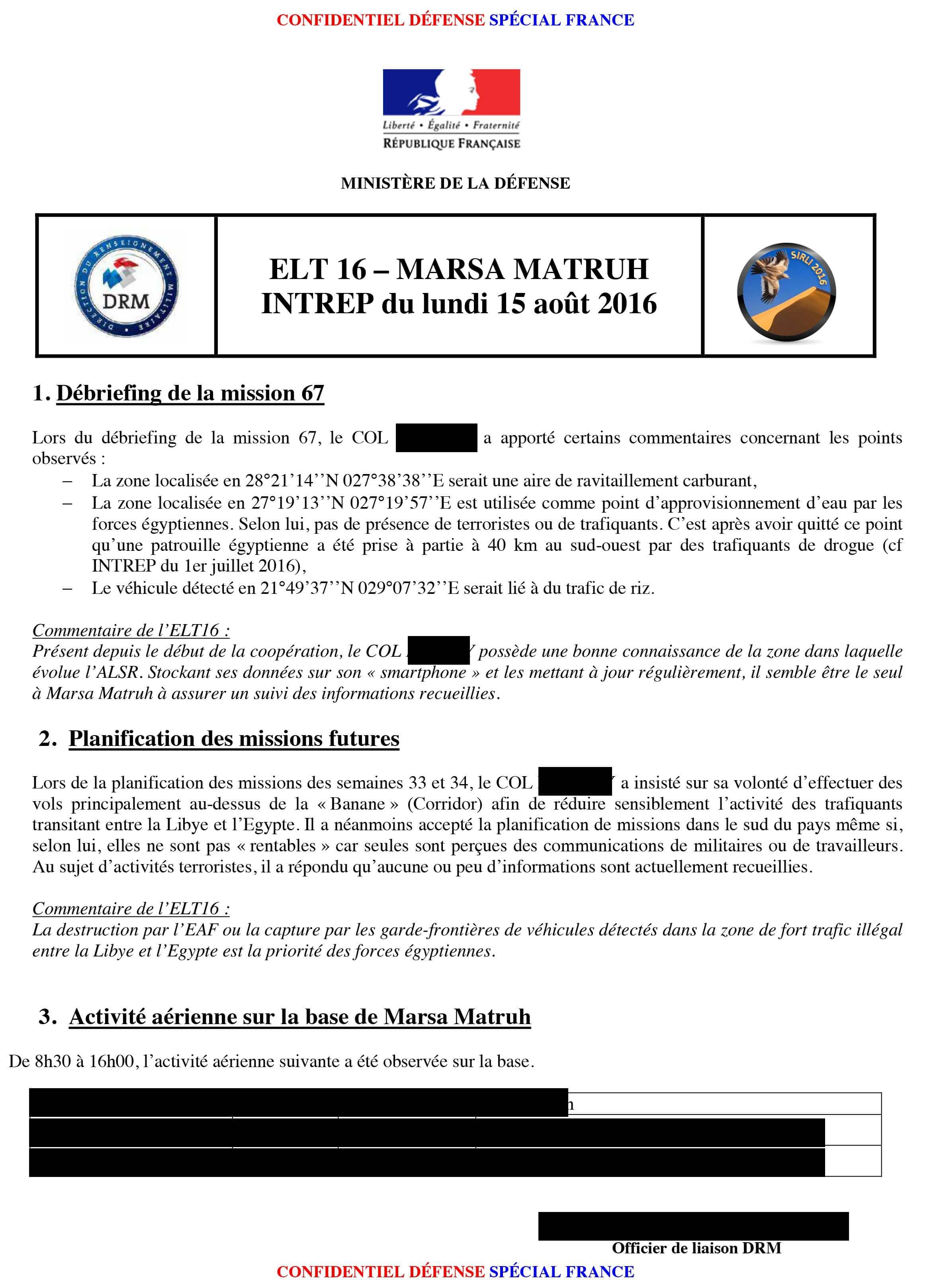
Report of August 15th 2016
“The [Egyptian] colonel had insisted on his wish to carry out overflights of the ‘banana’ in order to markedly reduce the activity of traffickers transiting beetween Libya and Egypt.”
The vast desert zone that leads from south of the Siwa oasis to the towns of the Nile Delta was nicknamed the “banana” by an Egyptian officer. It was in this zone, according to him, that were concentrated the pick-up trucks used by smugglers travelling into Egypt from the Libyan border, and which were heading for Cairo, Alexandria and the Nile Valley. The four-wheel drive vehicles, driven mostly by young civilians aged between 18-30, can be carrying cigarettes, or drugs or weapons, but also petrol, rice, cereals and make-up products, as was detailed in one classified document by the DRM.

Disclose travelled to the region around Marsa Matruh, where nearly 50% of inhabitants live below the poverty line. There, involvement in contraband activity is seen by many as an escape from working in the olive or date fields. “When you work from morning to night in the fields, you earn just 120 Egyptian pounds [editor’s note, 6.61 euros]. With that, you can’t even buy a kilo of meat,” said a former public employee who lives at the heart of the border zone. “When the youngsters around here – who are never more than 30-years-old and who are sometimes married with young children – see a guy building a villa or a large garden, they want the same, without thinking about the danger.”
Disclose spoke with a former smuggler from the zone who now works in tourism. “A pick-up driver loaded up with cigarettes earns 3,800 euros for a return trip between Libya and Egypt,” he said. That sum represents almost 40 times the average monthly wage in Egypt, and which understandably draws candidates despite the mortal danger involved. In July 2020, the Egyptian presidential office announced that over the previous seven years. “10,000 vehicles filled with terrorists and smugglers” had been destroyed, and “40,000 people killed”.
But according to Jalel Harchaoui, a researcher with the Swiss NGO Global Initiative Against Transnational Organized Crime, the terrorist threat from Libya is “largely overestimated by the Egyptian army in order to obtain support on the international stage”. Since 2017, no terrorist group or Islamist organisation is known to be implanted in eastern Egypt. According to a report in May 2020 by the European Institute of Peace, an independent foundation for conflict resolution, there was virtually no evidence to indicate that that the Islamic State group, or other armed groups, used drugs trafficking to fund their activities in Libya.
The Source“Only civilians are killed. Terrorists don’t roam in this part of the desert, they are above all concentrated in the Sinai, in the far north-east of the country.”
At the end of the summer of 2016, the DRM agents were unambiguous in their conclusion that the mission was of no interest. Especially because the areas that were flown over remained strictly limited to the west of the country, where armed groups are almost non-existent. They were prohibited from covering territory in Libya and Sinai, where the terrorist threat was real. A member of the Sirli team underlined this in a September 2016 report.
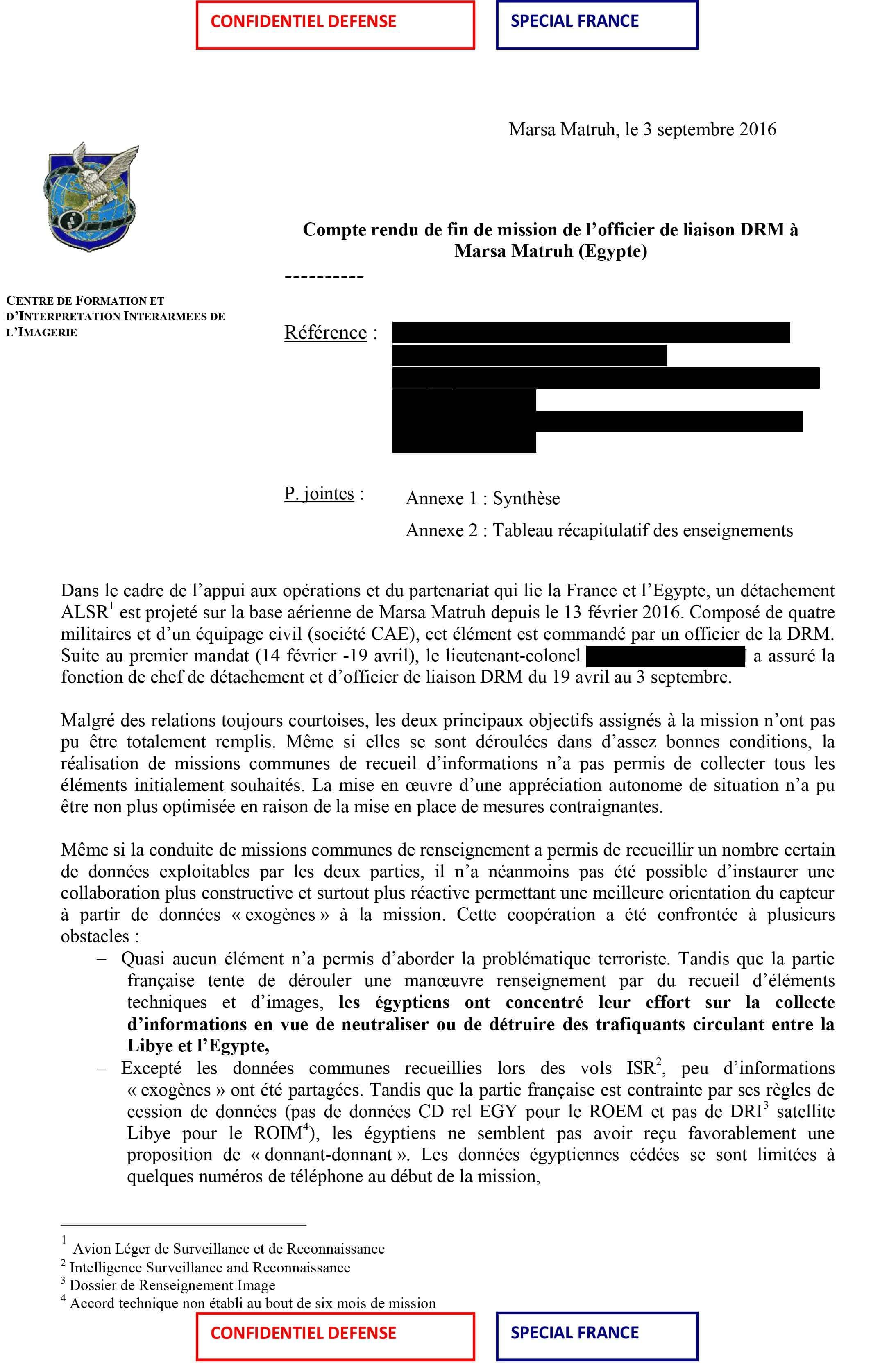
REPORT of September 3rd 2016
“Virtually no element has allowed to deal with the terrorist problem.”
“The impossibility of overflying Libyan territory as well as the Sinai has limited the collection of information to the border zones.”
“The priority of the mission is for the satisfaction of the needs of the partner.”
To satisfy its obsession with security, the dictatorship was ever more demanding, such as “the creation of a short loop for information transmission” from the plane to the base. The aim of this was to allow the Egyptian air force to fly to the zone to “treat” the target as quickly as possible. That request was of concern for the French personnel in the field, but not the leadership of France’s military intelligence which accepted this reduction of the transmission time of data. As a result of that, noted the agent who prepared the September 3rd report, “the involvement of the Egyptian air force in the destruction of traffickers was more visible”. The intelligence mission now had but one objective: to target vehicles on behalf of the Egyptian air force.
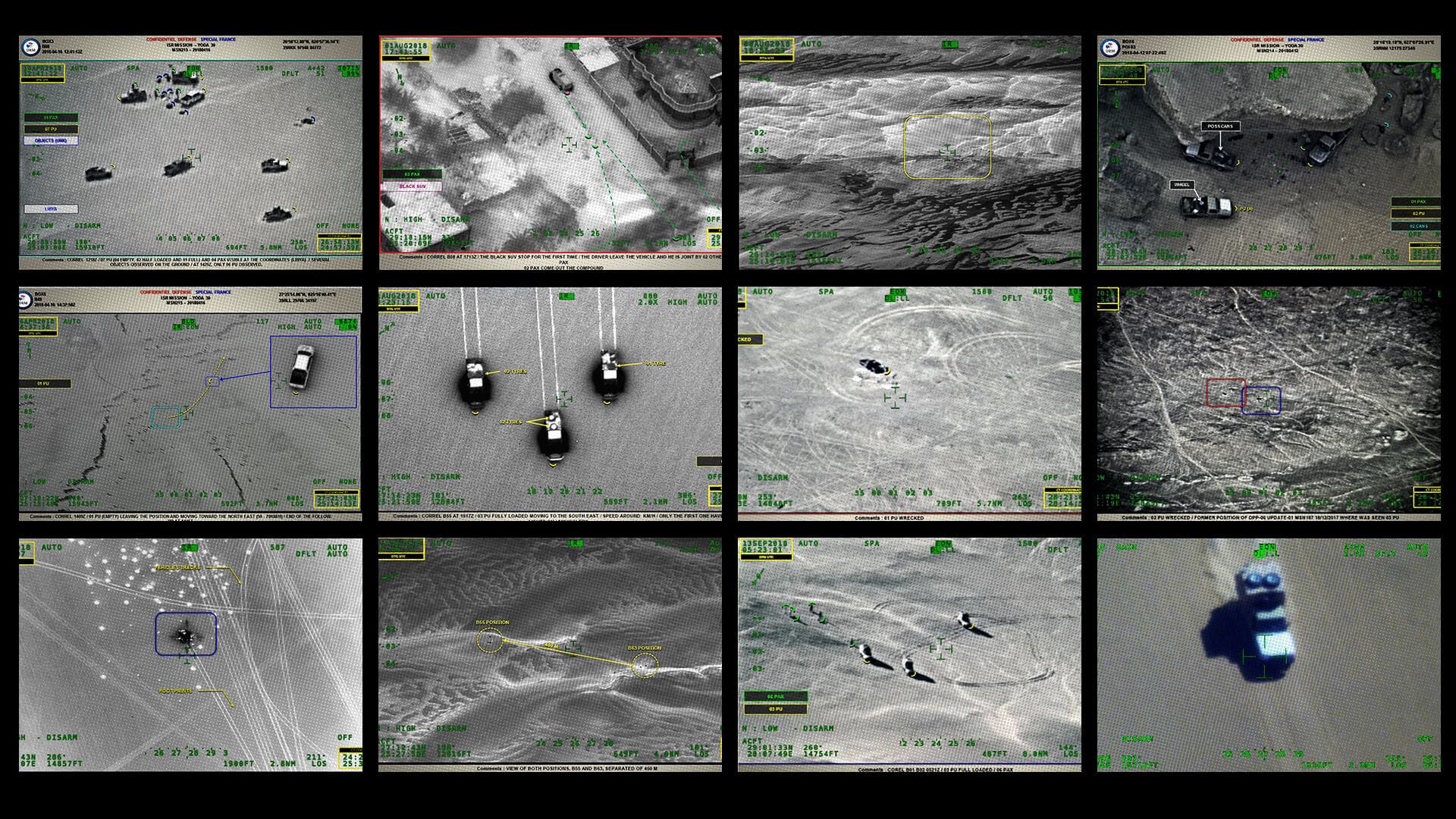
FAILURE OF THE MISSION
On September 21st 2016, members of the Sirli team took off from Marsa Matruh aboard the Merlin III French surveillance plane. After several hours flying above the desert, they spotted a convoy of pick-up trucks speeding over the dunes. The team in the plane transmitted the location of the convoy to their colleagues back at base, who subsequently transmitted the information on to the Egyptian air force. Thanks to the “short loop”, an Egyptian Cessna 208 aircraft arrived over the zone shortly after. The French had to change direction to avoid a collision. When they flew back over the spot 43 minutes later, a vehicle was on fire.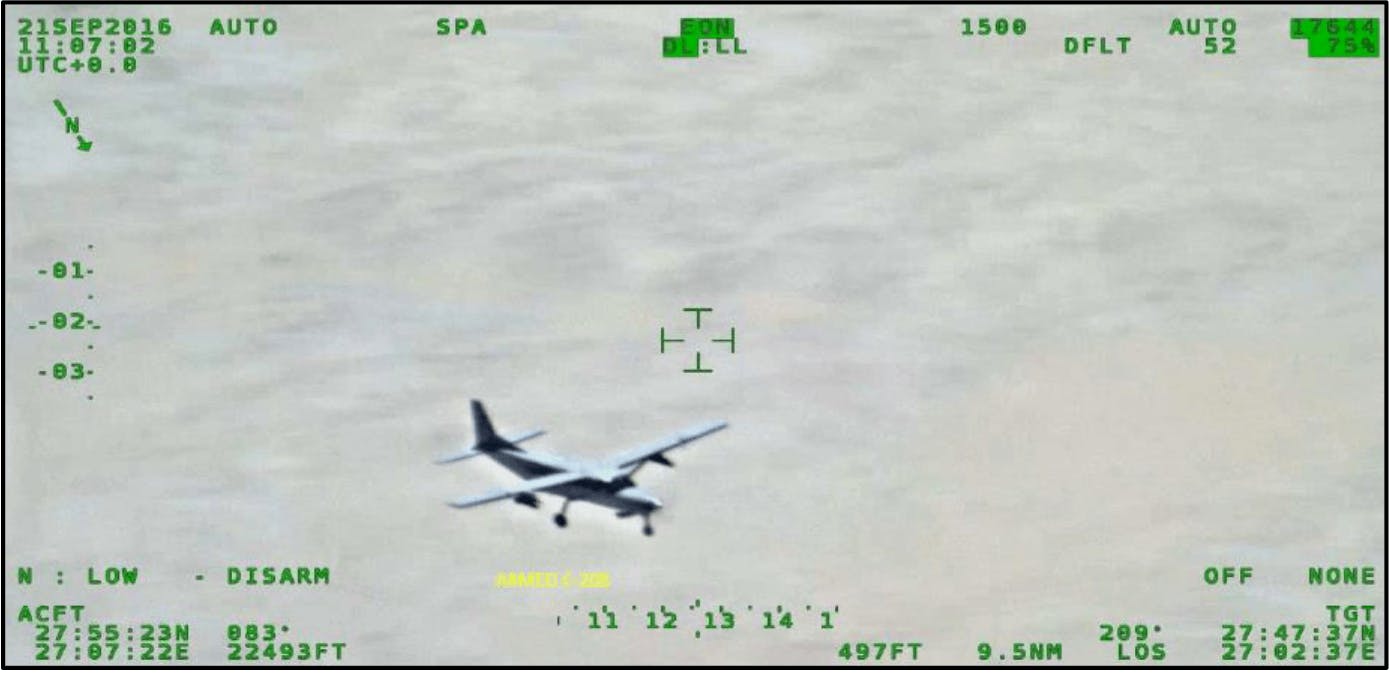
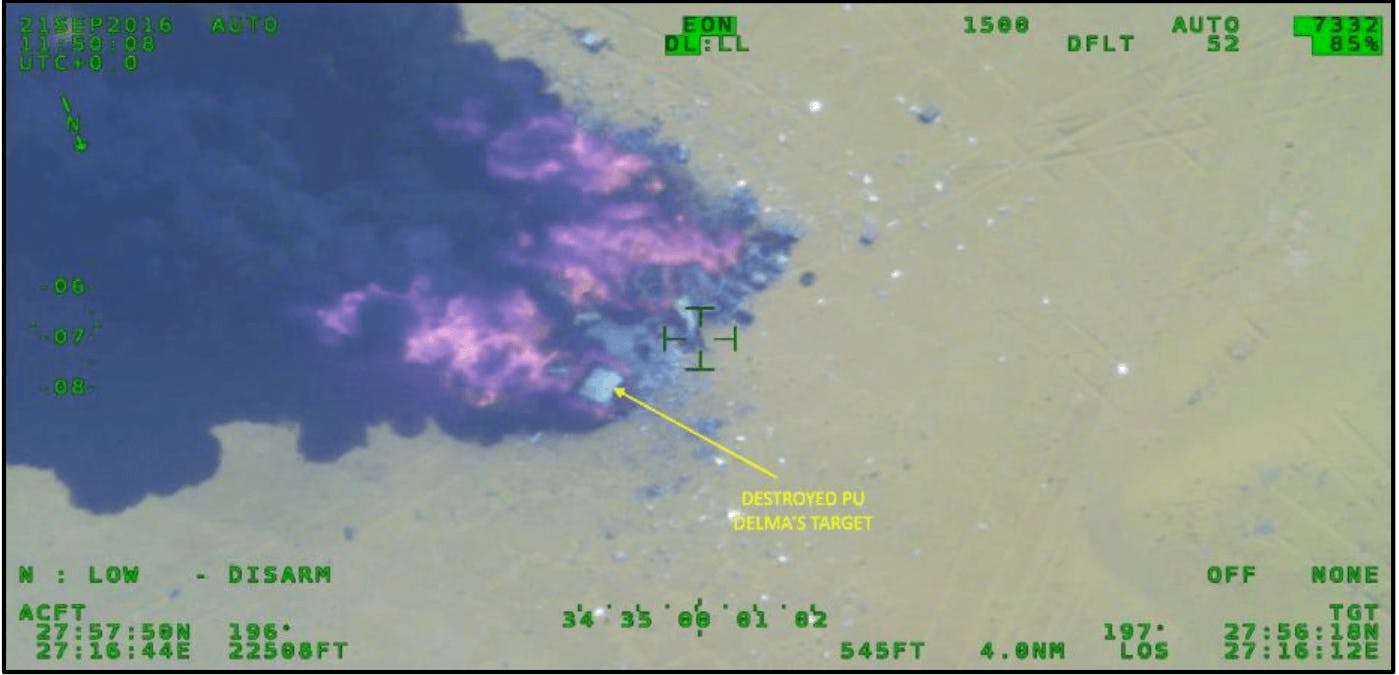
The following day, a DRM liaison officer informed his hierarchy that, “The strike was very probably perpetrated by the Egyptian air force Cessna 208”. He added:
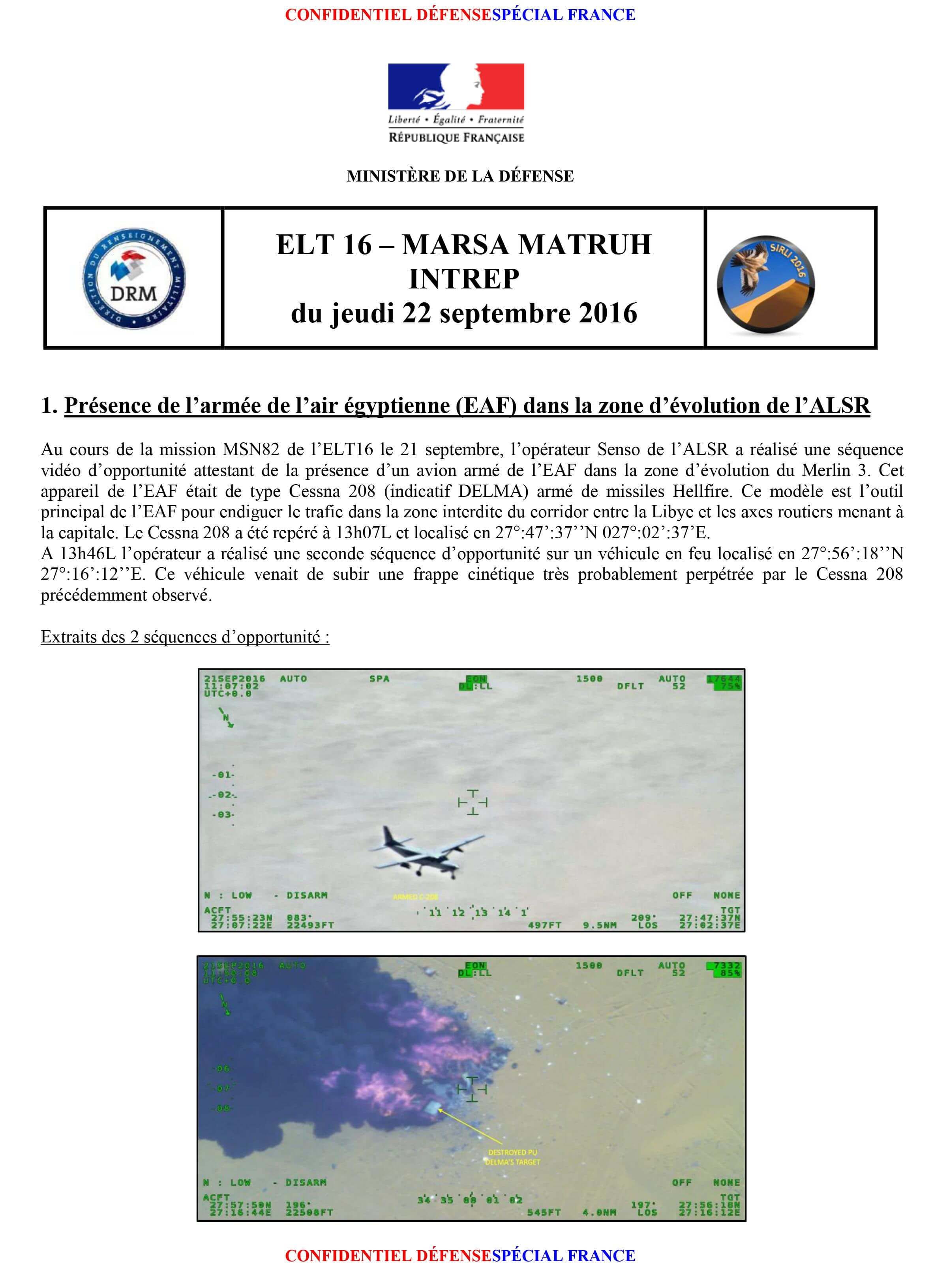
Report of September 22nd 2016
“The presence of the armed Cessna alone testifies to the will of the Egyptian air force to use the [supplied] information for repressive ends against the local traffic.”
A few days after that strike, the Egyptian military announced they had destroyed eight pick-up trucks along with their occupants, who were suspected smugglers. By supplying the information about their location, the French state had in effect made itself an accomplice of arbitrary executions.
By the end of 2016, the failure of the mission was no longer in doubt.
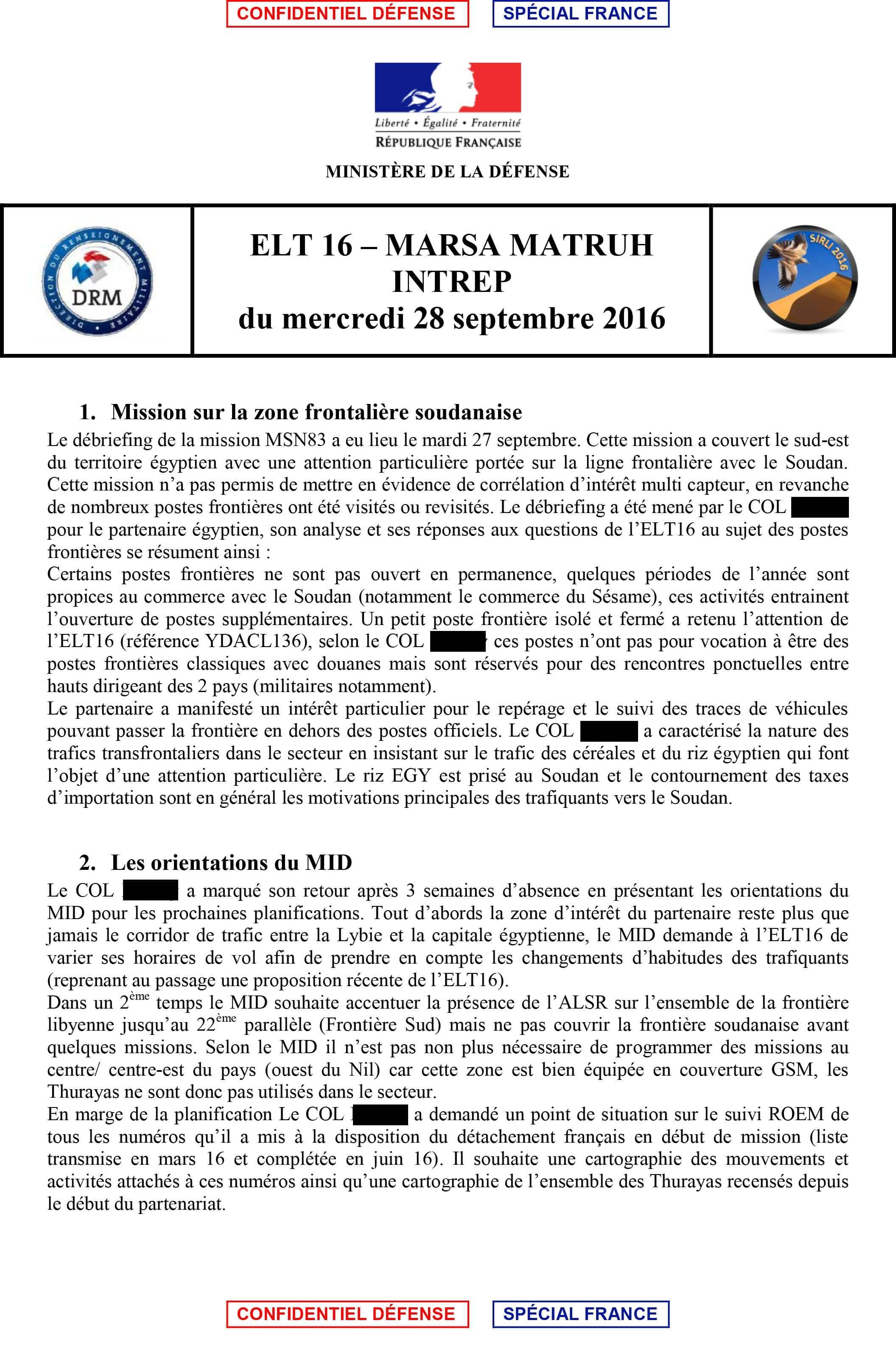
Report of September 28th 2016
“ELT 16 remains very vigilant but nevertheless worried about the use made of [information] for [targeting] purposes. »
SUPPORT NOT-FOR-PROFIT INVESTIGATIVE JOURNALISM
SUPPORT DISCLOSE
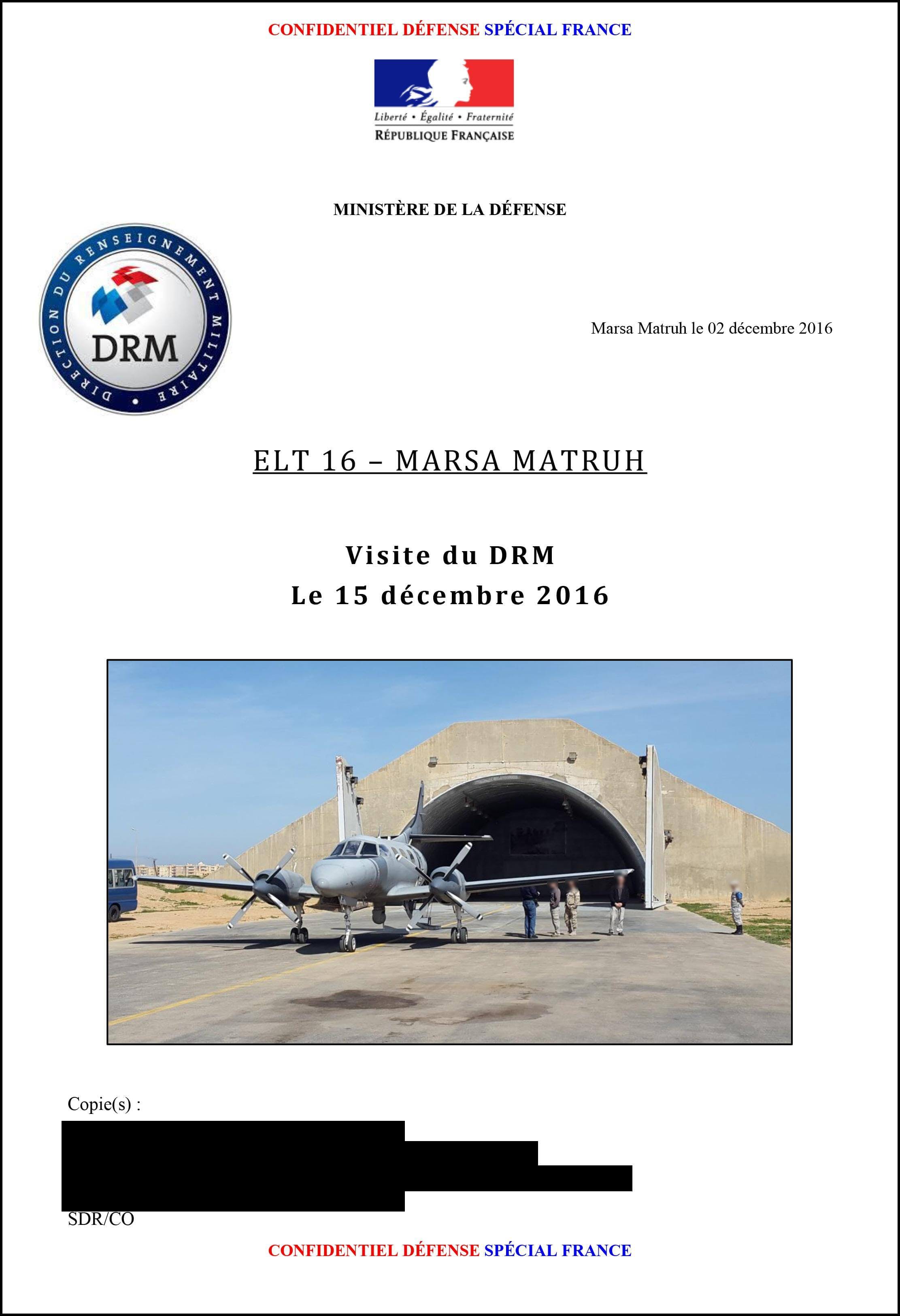
Report of December 15th 2016
“The Egyptian air force places constant pressure on the planning of missions so as to make maximum use of the ALSR capacities for its benefit.”
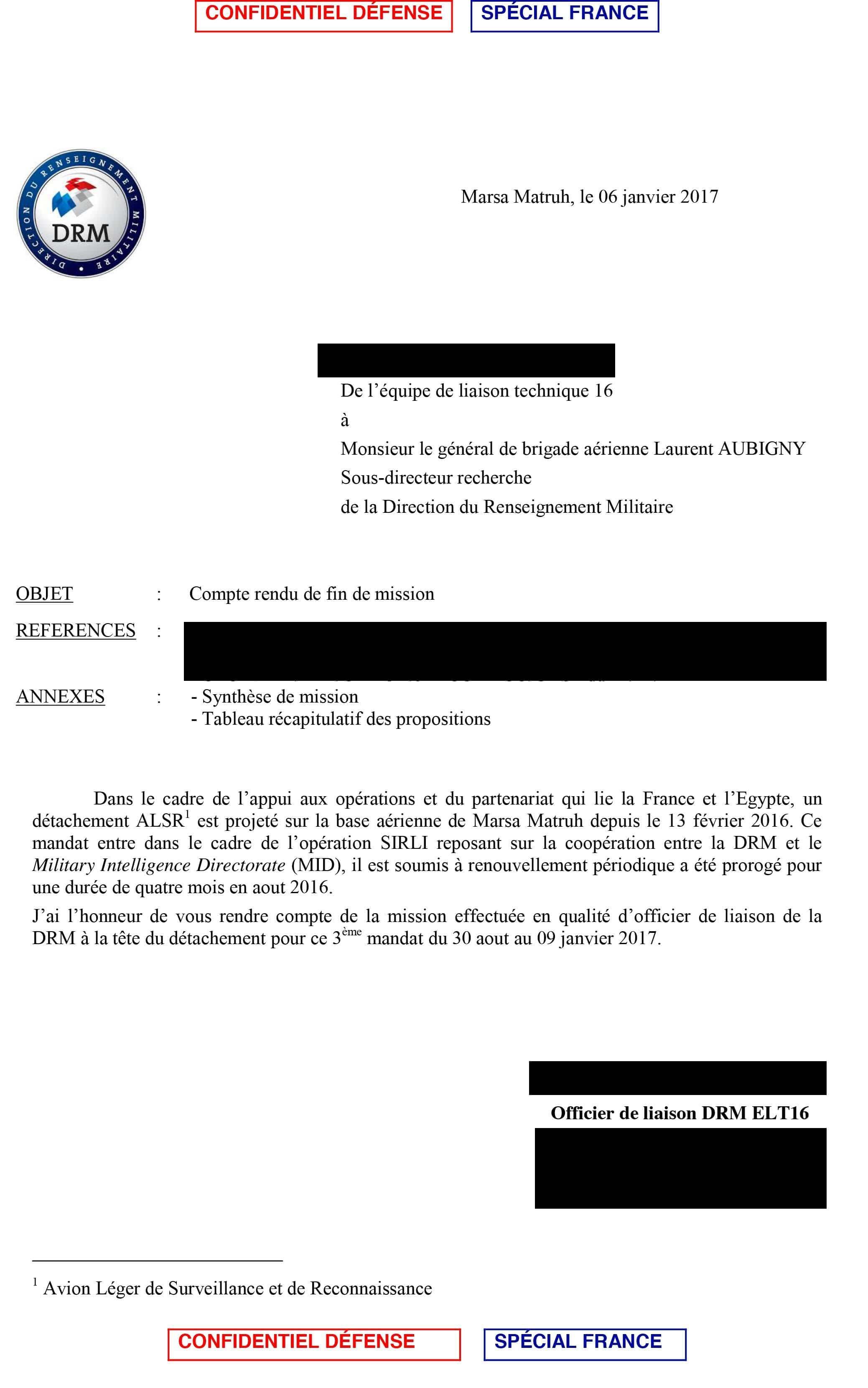
Report of January 6th 2017
“The terrorist problem has never been raised.”
According to the classified documents obtained by Disclose, the French forces may have been involved in at least 19 bombings of civilians between 2016 and 2018. The strikes often destroyed several vehicles, and the number of victims could be as many as several hundred. According to the criteria of United Nations General Assembly resolution 56/83, the complicity of France in these illegal executions could be established.
On May 7th 2017, Emmanuel Macron was elected as president of France. “Europe and the world expect us to defend, everywhere, the spirit of the Enlightenment, [which is] threatened is so many places,” announced Macron that night, speaking to crowds at the Louvre esplanade in Paris. “They expect that we defend, everywhere, freedoms, [and] that we protect the oppressed.”
However, the newly elected president was to very soon confirm that France would continue its cooperation with the Egyptian dictatorship.
Three weeks after his mandate began, Macron made a phone call to his Egyptian counterpart, Abdel Fattah al-Sisi, following a terrorist attack in Egypt days earlier against the Christian Copt community, for which the Islamic State group claimed responsibility. According to a summary of the conversation, it very soon focussed upon the military partnership between Paris and Cairo. Macron assured Sisi that he was “perfectly informed about ongoing operations” in Egypt.
The next day, France’s chief of staff of the armed forces, Pierre de Villiers, who is placed under the authority of the French president, received a report, classified as secret. Written by the director of military intelligence, the DRM, the detailed report noted that most of the pick-up trucks that were localised in the Egyptian desert were not connected with terrorist groups.
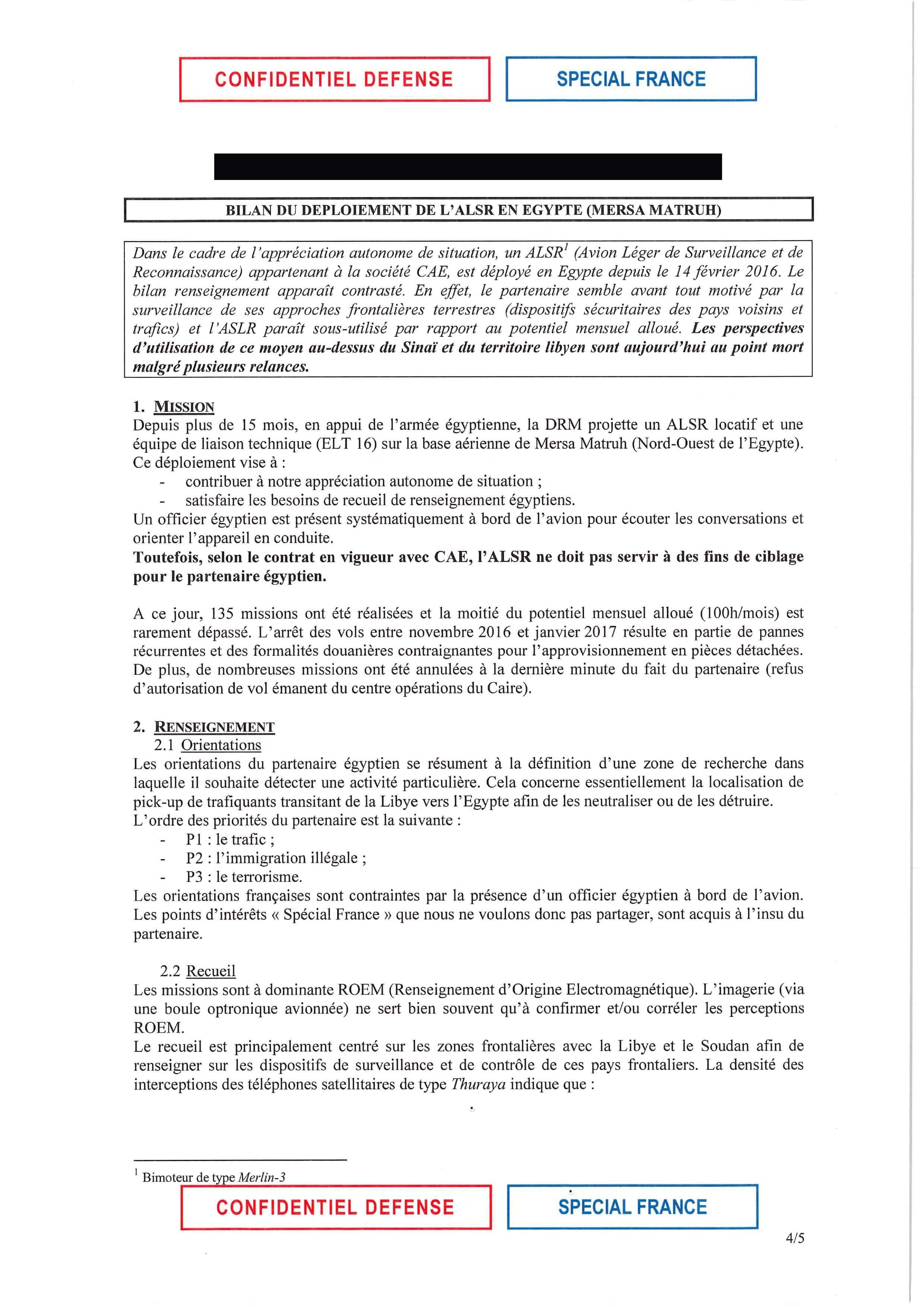
Report of June 1st 2017
“The itineraries of the traffic are principally linked to ‘simple’ Bedouin professional smuggling.”
The head of the DRM then underlined Egypt’s “order of priorities”. The fight against terrorism came in third place.






